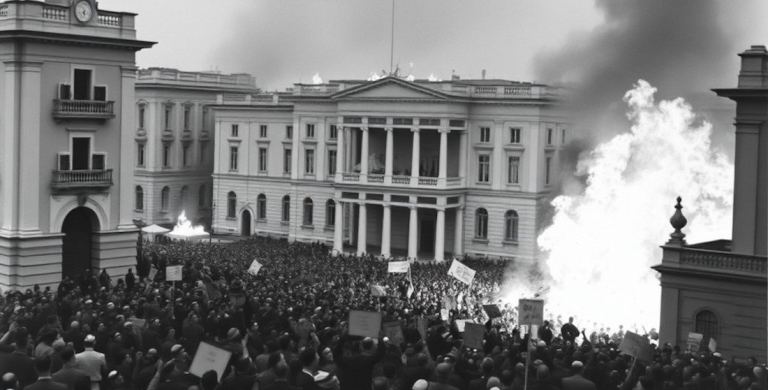
Unraveling the Roots and Resilience of a Nation Torn Apart
Bogotá — La Violencia, a period of intense civil conflict in Colombia, claimed over 200,000 lives and displaced millions between 1948 and 1958.
Sparked by the assassination of Liberal Party leader Jorge Eliécer Gaitán, this era of violence pitted Liberals against Conservatives in a brutal struggle for power. Rural communities bore the brunt, as armed groups unleashed terror across the countryside. Understanding this tragedy highlights Colombia’s resilience and ongoing efforts to heal.
A Nation Divided
The roots of La Violencia trace back to deep-seated political rivalries between the Liberal Party and Conservative Party, which had long competed for control. By the 1940s, Colombia’s political landscape was polarized, with economic inequality and land disputes fueling tensions. The assassination of Gaitán on April 9, 1948, in Bogotá, ignited widespread riots known as the Bogotazo. This event marked the beginning of a decade-long conflict, as partisan militias targeted civilians based on political allegiance.
The violence was not confined to Bogotá. Rural areas, particularly in Antioquia, Tolima, and Valle del Cauca, became battlegrounds. Armed bands, often backed by local elites, committed massacres, rapes, and forced displacements. The Colombian government, struggling to maintain order, often failed to protect vulnerable populations, leaving communities to fend for themselves.
The Human Toll
La Violencia was defined by its brutality. Entire villages were razed, and families were torn apart. By 1958, an estimated 2.7 million people—nearly a quarter of Colombia’s population—were displaced.
The conflict disproportionately affected campesinos (rural peasants), who faced land theft and violence from both Liberal and Conservative militias. Women and children were frequent victims, with reports of targeted atrocities aimed at breaking community cohesion.
The Colombian Catholic Church, a powerful institution, played a complex role. While some clergy advocated for peace, others aligned with Conservative factions, deepening divisions. The lack of a unified response from civil society allowed the violence to escalate unchecked.
Why It Persisted
La Violencia endured due to a combination of political intransigence, economic inequality, and weak state institutions. The Colombian government’s inability to address land reform or mediate between factions prolonged the conflict. External factors, including the Cold War, also played a role, as the U.S. supported Conservative-led governments to counter perceived communist threats, indirectly fueling the violence.
The absence of a clear military objective distinguished La Violencia from traditional wars. Instead, it was a decentralized conflict driven by vengeance and local power struggles. This made it difficult for the Colombian military or international actors like the U.N. to intervene effectively.

Path to Reconciliation
By the late 1950s, exhaustion and mutual recognition of the conflict’s futility led to a resolution.
In 1958, the Liberals and Conservatives formed the National Front, a power-sharing agreement that alternated presidency between the two parties.
While this ended large-scale violence, it did not address underlying issues like land inequality, setting the stage for later conflicts involving groups like FARC.
Colombia’s recovery has been remarkable.
Today, the nation is a leader in peacebuilding, with initiatives like the 2016 peace accord with FARC demonstrating commitment to reconciliation.
Community-led programs and truth commissions have helped survivors share their stories, fostering healing and accountability.
Story Behind Dark Decade ‘La Violencia’ in Colombia’s Civil War (May 13, 2025)
#ColombiaHistory #LaViolencia #Peacebuilding #CivilWar #Reconciliation
Tags: Colombia, La Violencia, civil war, peacebuilding, Liberal Party, Conservative Party, Bogotazo, National Front
Social Media
X Blurb
Colombia’s Dark Decade of La Violencia: Unraveling a brutal civil war’s impact. #ColombiaHistory #Peacebuilding bit.ly/3xyz123
Bluesky Blurb
Colombia’s Dark Decade of La Violencia tore a nation apart. Discover its causes and healing journey. #ColombiaHistory #Peacebuilding bit.ly/3xyz123
LinkedIn Blurb
Colombia’s Dark Decade of La Violencia highlights the devastating impact of political division and inequality. This civil war’s legacy underscores the importance of peacebuilding and reconciliation for societal stability. Learn how Colombia’s resilience offers lessons for global conflict resolution. #ColombiaHistory #Peacebuilding #SocialImpact www.stewardshipreport.org/colombia-la-violencia
Truth Social Blurb
Colombia’s Dark Decade of La Violencia: A brutal civil war’s lasting impact. Explore its roots and recovery. #ColombiaHistory bit.ly/3xyz123
Mastodon Blurb
The story of La Violencia in Colombia reveals a nation scarred by civil war but resilient in peacebuilding. From brutal conflict to reconciliation, discover how Colombia heals. Colombia’s Dark Decade of La Violencia. #ColombiaHistory bit.ly/3xyz123
Instagram Blurb
Colombia’s Dark Decade of La Violencia shaped a nation. Learn about its impact and recovery. Read more via bio link!
#ColombiaHistory #Peacebuilding #LaViolencia #CivilWar #Reconciliation
Facebook Blurb
From the ashes of La Violencia, Colombia rebuilt itself. This brutal civil war left scars but also lessons in peacebuilding. Colombia’s Dark Decade of La Violencia explores the conflict’s roots and the nation’s inspiring recovery. #ColombiaHistory #Peacebuilding www.stewardshipreport.org/colombia-la-violencia
Reddit Blurb
Colombia’s Dark Decade of La Violencia claimed 200,000 lives and displaced millions. What can its story teach us about preventing civil conflict? Explore the causes, impact, and Colombia’s path to peacebuilding. Colombia’s Dark Decade of La Violencia. #ColombiaHistory bit.ly/3xyz123